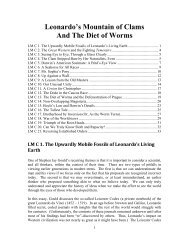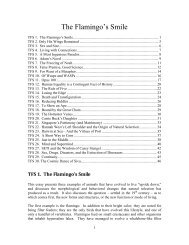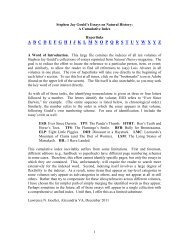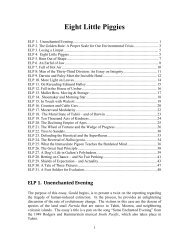Dinosaur In a Haystack - A Website About Stephen Jay Gould's ...
Dinosaur In a Haystack - A Website About Stephen Jay Gould's ...
Dinosaur In a Haystack - A Website About Stephen Jay Gould's ...
You also want an ePaper? Increase the reach of your titles
YUMPU automatically turns print PDFs into web optimized ePapers that Google loves.
earth would be relatively localized. Gould notes that the estimated diameter of the KTimpact object is several times larger than the fragments that struck Jupiter.Gould wrote this essay only a few days after the impacts occurred, and expresses acertain degree of vindication for his early support of Alvarez’s theory. A fraction of thescientific community remained unconvinced that the impact associated with the globaliridium layer was responsible for the cretaceous-tertiary mass extinction. [<strong>In</strong> retrospect,it appears that few of these had their minds changed by Shoemaker-Levy. It was,however, empirically reassuring to those who had come to accept this view.] Gouldreiterates his opinion that there is another, more fundamental component to thisresistance. Continuous, gradual change has been one of the most important underlyingthemes of the earth sciences for 150 years. Here he discusses why Charles Lyell, alawyer by training, presented the “case” that catastrophic events should be completelyexcluded from the science of geology in his three-volume work Principles of Geology[see ESD 18, and the previous essay]. Forces that humans have observed in the past fewthousand years, he argued, combined with vast amounts of time, can explain everythingwe observe today; allowing catastrophic speculation will “foster indolence and blunt thekeen edge of curiosity.” England’s leading philosopher of science at the time, WilliamWhewell, coined the terms “uniformitarian” and “catastrophist” in an important review ofVolume II of Lyell’s work in 1832. He did so to illustrate the essence of Lyell’sperspective, and Lyell himself embraced this dichotomy. Whewell, however, noted inthis review that the absence of exceptionally large catastrophic events in recorded historydid not preclude them. But Lyell effectively “won his case,” and geologists (as well aspaleontologists) came to view all catastrophic proposals with a jaundiced eye. Thisserved the purpose of discouraging ongoing baseless speculation, but led to anoverreaction (Gould claims) when it came to Alvarez – who actually did have scientificevidence to support his proposed catastrophe.There is another aspect to the philosophical (psychological?) discussion, he continues.The concept of uniform, steady change is consistent with a “comforting view of naturalhistory” (Gould’s phrase): steady progress toward inevitable results. The view that rare,catastrophic, and partially random events played a major role in the formation of ourexistence is disturbing to many people. William Glen, a geologist, historian of science,and colleague of Gould’s, had written a book on how the theory of plate tectonicsrevolutionized geology. Glen later told Gould that he considered the K-T impact andresulting mass extinction to be far more revolutionary, from an intellectual perspective.<strong>In</strong> the end, plate tectonics fits under the uniformitarian conceptual umbrella, while animpact-induced extinction does not. Gould references Freud, who claimed that all greatintellectual revolutions must alter some central concept about how humans viewthemselves [DIH 25, LMC 15]. Such an event implies that human existence was notdependent on the superiority of mammals to dinosaurs and progressive forces, but to achance, catastrophic event.DIH 14. Poe’s Greatest Hit19








